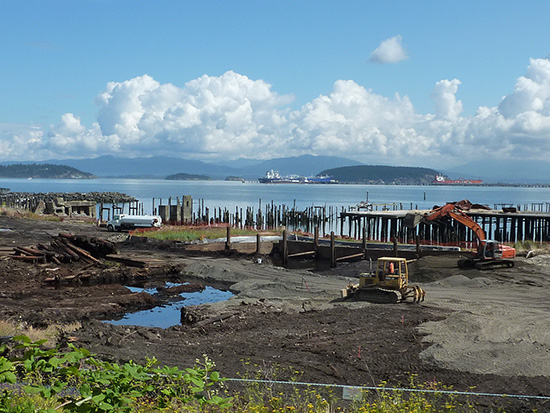|
Subscribe / Renew |
|
|
Contact Us |
|
| ► Subscribe to our Free Weekly Newsletter | |
| home | Welcome, sign in or click here to subscribe. | login |
Construction
| |
 |
January 26, 2015
Social/economic sustainability
Best in State: Gold award
Hart Crowser
Project: Custom Plywood Mill site cleanup
Client: Washington State Department of Ecology
The Custom Plywood Mill site cleanup serves as a shining example of how public agencies, local governments and the consulting community can optimize scarce public funds to achieve the transformation of a once-blighted and severely degraded industrial property back to a productive and thriving economic and ecological community.
The Custom Plywood project is unique because of its large size, high visibility, public interest, stakeholder involvement and overall scope of the project.
From the outset this has been more than a cleanup project. It is a restoration of a beautiful stretch of public shoreline involving a multidisciplinary team of environmental, geotechnical and civil engineers, wetland and fisheries biologists, coastal geomorphologists and cultural resource/archaeological professionals.
The mill site, located in Anacortes, is the largest ever cleanup funded by Washington state.
Industrial operations at the site began in 1892 and included a succession of mills: sawed lumber and trim, shingles, box parts, wooden water pipes and plywood. Over 100 years, mill operations contributed to the deposition of approximately eight acres of wood waste and fills, thousands of creosote-treated piles and industrial debris — including remnants of two substantial fires, the last of which leveled the facility in 1992.
The mill operations had left a legacy of contamination, including toxic hydrocarbons, dioxins and metals. While the decay of wood waste is a natural process, the huge quantities of waste decreased the amount of available dissolved oxygen in the water and released hydrogen sulfide and ammonia, all of which are toxic to sea life.
The solution involved separate interim remedial actions to address the upland and in-water impacts.
The upland remedy involved demolishing all upland structures, excavating and disposing of 30,000 tons of contaminated soil and waste, removing more than 1,000 piles, and constructing an estuarine wetland complex.
The in-water remedy included removing 1,400 creosote piles, demolishing remaining in-water structures, removing 52,000 tons of contaminated sediment, and placing 140,000 tons of new habitat substrate.
The myriad of habitat enhancements — including upland plantings, forage fish habitat restoration, construction of a new estuarine wetland complex, and an aquatic spit and protective jetty extension to protect the wetland and shoreline enhancements from winter storms — ensure long-term ecological and economic productivity.
All of this work ultimately resulted in a complete transformation of the site.
Other Stories:
- National finalist: Platinum award
Magnusson Klemencic Associates - Complexity
Best in State: Gold award
Parametrix - Future value to engineering profession
Best in State: Gold award
Herrera Environmental - Future value to engineering profession
Best in State: Gold award
David Evans and Associates - Originality/innovation
Best in State: Gold award
Tetra Tech - Transportation
National finalist: Gold award
Jacobs/GeoEngineers - Structural systems
National finalist: Gold award
CKC Structural Engineers - Structural systems
National finalist: Gold award
HNTB Corp. - Structural systems
National finalist: Gold award
Buckland & Taylor - Structural systems
National finalist: Gold award
Hart Crowser - Exceeds owner/client needs
Best in State: Gold award
Hart Crowser



